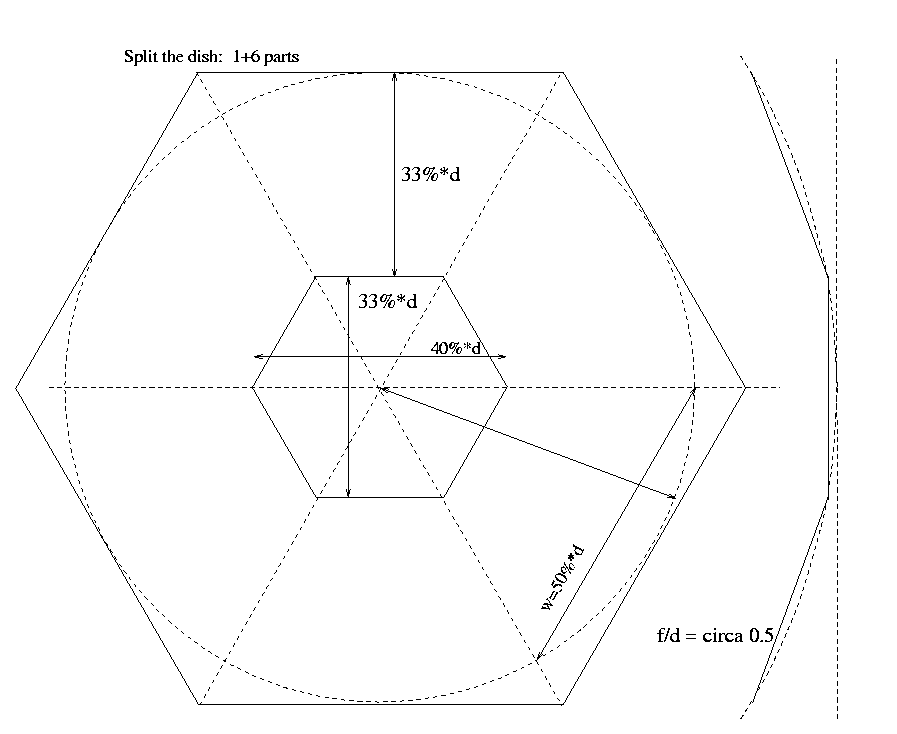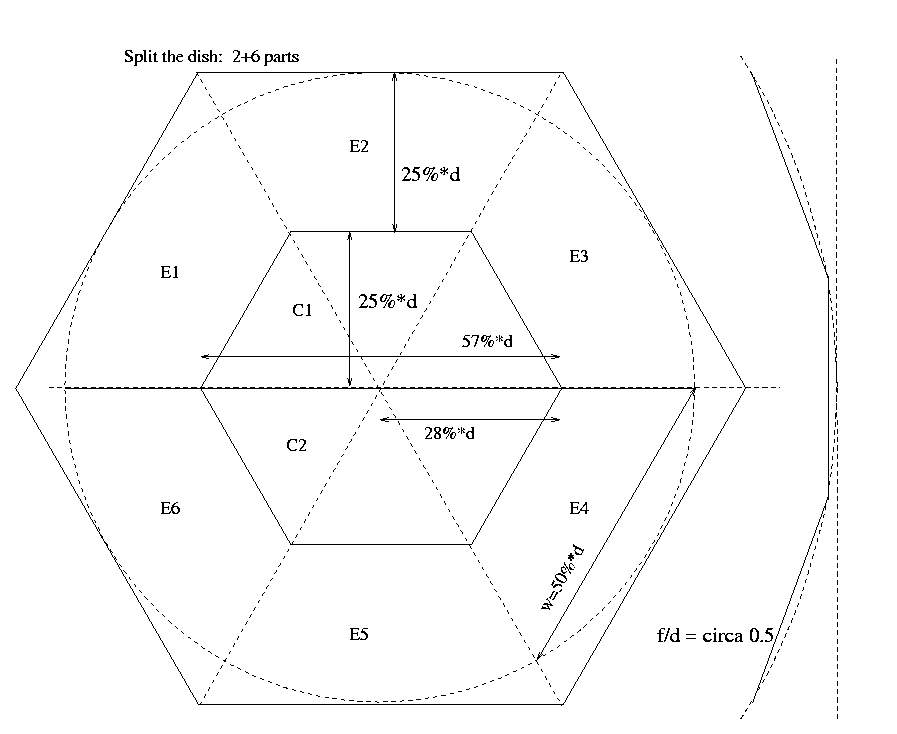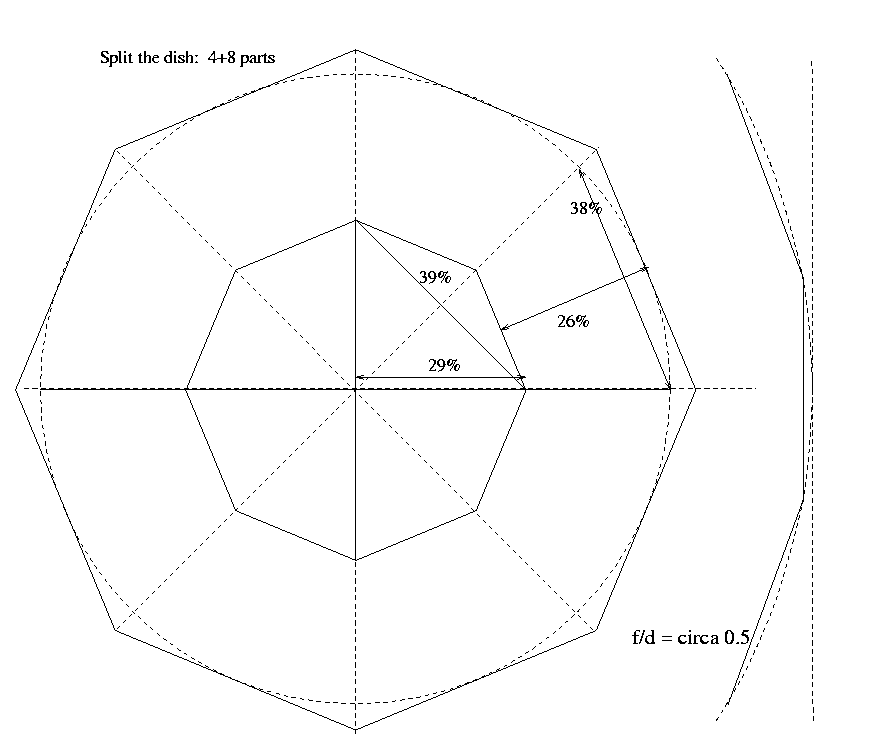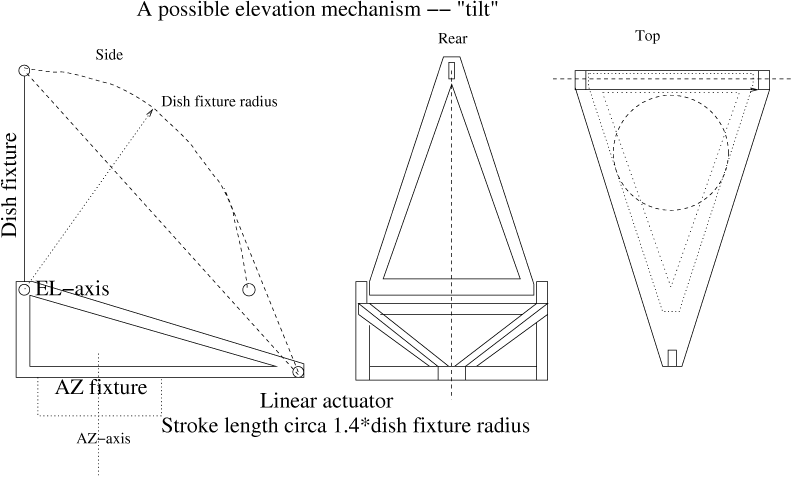``Portadish v.2'' -- ways to split a big dish for portability
``X-band EME station in a trailer''
``Who has the biggest dish at the camp ?''
The split pictures below are projected orthogonal to beam direction,
and and therefore the widths are somewhat wrong as especially the
edge parts are considerably tilted from flat plane.
The Radial dimension error is something in order of 6 to 9 percent.
More so with narrower edges of the "25%" cases.
Some geometry studies aiming at a car trailer ``portable''
large aperture dish in a compact package
Some boundary conditions for the design:
- Trailer mass limit: 900 kg (2000 pounds)
- Trailer external width limit: 2000 mm (2 meters, 6.5 feet)
- Trailer length limit: 4000 mm (4 meters, 13 feet)
- Using for example trailer ``Muuli 1800KUJ'' as base
(there).
Self-mass of the trailer: 330 kg.
Its flatbed cargo space dimensions are 1800mm*3500mm.
A few odd thoughts...
- Constructable quickly with very few tools (propably can't do without any)
- Mass-limit mandates that light-weight (marginally ``flimsy'') construction
methods need to be used
- Dish must be split into manageable size bits which fit horizontally into the trailer
- Dish should possibly be letting wind thru (e.g. a fine mesh for the reflector surface -- but that is mechanically sensitive..)
- Having some extra space in the trailer for other bits than just the
dish and pedestal would be nice, e.g.:
- couple aggregates
- fuel for the aggregates
- couple large tents
- foldable tables, chairs, field beds
All in all, say 250 kg of support equipment -->
which means the trailer and dish weight must be under 650 kg
- Moon apparent diameter varies in between 0.49 to 0.56 degrees,
with average being 0.52 degrees.
- For 3dB beam width, we pick 10.5 GHz (28.6 mm)
- Previous two give (via: lambda/theta=diam) diameters of: 3344/3151/2926 mm
(smaller diameter for wider beam)
- For X-band optimal beamwidth for moon,
on perigee conditions we should pick smallest diameter.
On the other hand, using largest of "optimal" size diameters gives
circa 20-25% underillumination at the perigee moon.
With ``average'' size, the underillumination is some 10-12% in
the perigee case.
- For 24 GHz the optimal diameter is around 1220-1400 mm, and for 1.3 GHz
that would be as much as 23-26 meters...
- All in all, it looks like a combined 10 GHz/24GHz dish would be optimal
for EME work where central circa 40% is optimized for 24 GHz, and the
rest are ``good enough'' for 10 GHz.
Split to 1+6 parts:
- Center part dimensions are 33.3%*40%
- Edge parts dimensions are 33.3%*50%

Split to 1+8 parts:
- Center part dimensions are 33.3%*38%
- Edge parts dimensions are 33.3%*38%

Split to 2+6 parts: (or perhaps 4+6)
- Center parts are either 57%*25%, or 28%*25% (two vs. four pieces)
- Edge parts are 25%*50%.

Split to 4+8 parts: (or 2+8)
- Center parts are 29%*29% (or 58%*29%)
- Edge parts are 26%*38%

About pedestal:
- An A-frame ``tower'' with a jack for raising it when
the dish has been constructed on top of it.
- When the A-frame is fully raised, the rotor unit shall be at
the top of mid-point of support jacks.
- While the dish is being constructed, the A-frame is flat,
possibly the rotator is at the top of the trailer pulling boom,
possibly even at the "wrong" side of the support point.
- During transport the A-frame must perhaps be detached from its
operational mount point

About EL rotor:
- Instead of a gear sector, use a linear actuator motor, e.g.
a sturdy model of TV Satellite dish turner
- Construct in light-weight, but strong profile ``cage-like''
structure, predominantly in triangle elements







